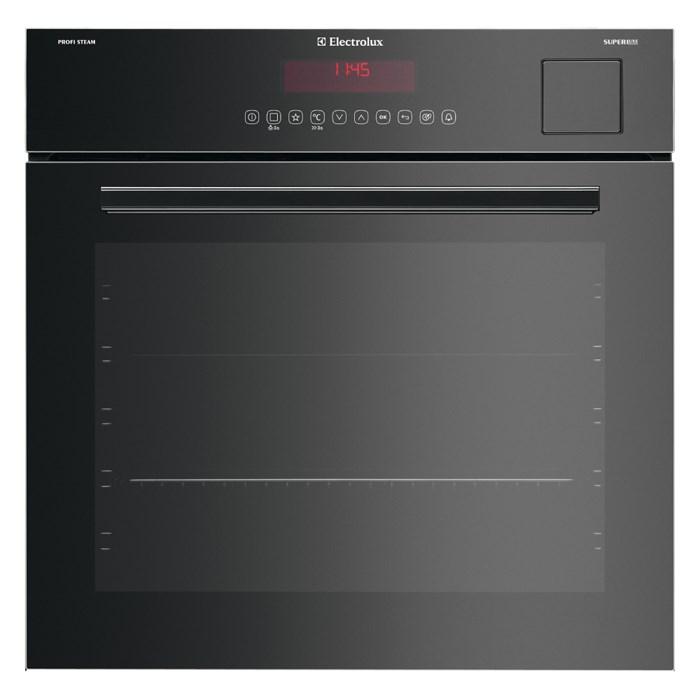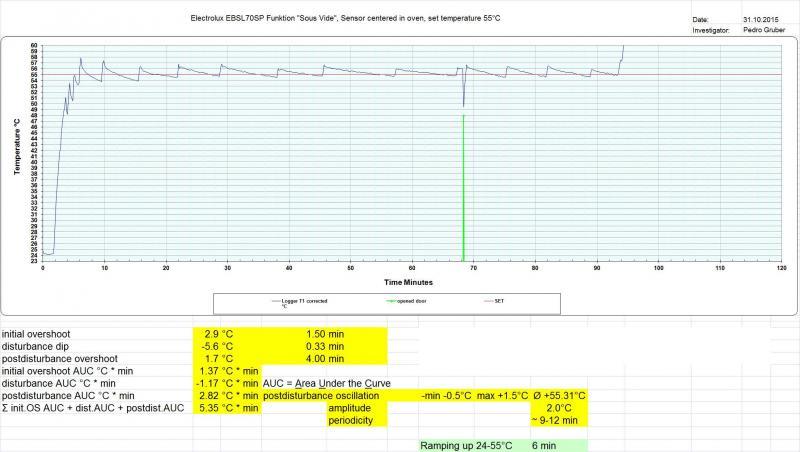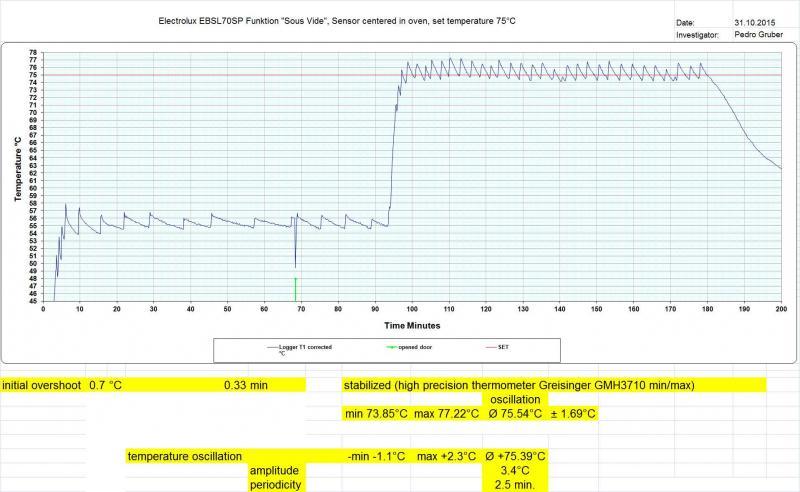-
Posts
518 -
Joined
-
Last visited
Content Type
Profiles
Forums
Store
Help Articles
Posts posted by PedroG
-
-
Welcome to Sous Vide Victor!
There used to be a sous vide page in WikiGullet, but unfortunately WikiGullet has been completely discontinued. I saved this sous vide page to the sous vide Wikia.
-
 2
2
-
-
As rotuts said, instead of one professional oven you might consider two Electrolux EBSL70SP so you can e.g. use one for sous vide and the other for baking at the same time, or any other combinations. They also have vacuum-sealer drawers that fit beneath the ovens.
-
 1
1
-
-
Hi KitchenQueen, welcome to the sous vide community!
In The Sous vide page from wikiGullet you will find basic information and an extensive chapter on egg cookery as well as a link to Douglas Baldwin's Practical Guide to Sous Vide Cooking which contains the important tables for cooking times and temperatures.
You will have a lot of satisfaction with sous vide cooking.
-
 2
2
-
-
Now finally I got the answers from Electrolux:
- Model EBSL70 is not marketed in the US and there are no plans to do so later.
- Demineralized water is aggressive and may influence corrosion of certain parts.
I am now doing sous vide for a few hours in the steamer, for longer cooking times I still use my SVM/FMM.
-
 2
2
-
Baldwin says to cook my fish for 15-20 mins (for med rare) at 122F. Problem is that I put in the cold fish and now the bath is at 89F. Do I wait for it to return to 122F before I start counting the cooking time?
It's grouper, btw.
Thanks.
It ended up taking all 20 minutes to get the water back to temperature. Then I cooked 20 minutes and checked--the fish was a little rare, so I cooked 5 more minutes. It was edible. It could have taken more, was raw-ish but I could cut through the fish and the edges were beginning to flake.
We ate it with some hot teriyaki sauce which was absolutely the right thing.
A temperature drop from 44°C to 32°C by adding some fish that's not even frozen is a strong indicator that your SV bath is way too small! A recovery time of 20 minutes means your heater is way too weak or your PID-tuning is not adequate. I never had such a problem with a 16-liter bath and a 2000W heater (SVM/FMM). What is your SV setup? If you are not obliged to pasteurize your fish, I would recommend something like 46-47°C core temperature for an optimal organoleptic outcome.
-
 1
1
-
-
One tip that is often missed is to dry the steaks when you take them out of the bag prior to searing. If you don't do this, the sear will not work properly.
After drying I run in oil and salt and put the steak on a searing hot pan (as hot as you can get it and preferably on a wok burner) -- don't use non-stick as the high heat will denature the surface.
Exactly! Brushing the dried steak with oil and using a dry pan instead of pouring oil into the pan avoids much of the splashing and oil mist wafting all over the stove and counter.
-
After sous vide pasteurization, unbagging, cutting and rebagging, surface pasteurization by dunking a few seconds in 80°C water should "reset the clock", so (according to Douglas Baldwin) you can keep it below 5°C for max. 10 days or below 3.3°C for up to 30 days, provided you did not poke into the meat.
-
 1
1
-
-
One day I might do a bit of homework as has been proposed.
I plan to repeat the experiment I did six years ago, but with one probe in the center and one just a few millimeters below the surface, doing the same experiment with the same vacuum-sealed pile of wet rags (which in contrast to meat slabs can be reused ad lib) once in the steamer and once in the SVM/FMM water bath.
-
 3
3
-
-
Specific heat of water is 4.186 J/g/°C whereas latent heat of steam is 2256 J/g, that's why condensing steam delivers more energy than surrounding water.
Edit: Oops, the previous posts were faster!
-
 1
1
-
-
My old convection oven had to be replaced, now I have a combi steam oven (Electrolux EBSL70SP). Temperature stability is much better than with the old convection oven which oscillated by 13°C around 55°C; the new oven has a sous vide function (100% steam) which allows setting temperature in 1°C increments from 50°C to 95°C, and at 55°C it oscillates within 2°C with a periodicity of about 9-12 minutes; at 75°C it oscillates within 3.4°C with a periodicity of 2.5 minutes.
My first experiment was "perfect poached eggs" 16 min at 75°C, they came out the same as I am accustomed to from the sous vide water bath.
My second experiment was racks of lamb (vacuum sealed with marinade and mustard about a month ago and kept at 1°C). Thickness was 45mm, so scheduled time was 3 hours at 56°C. Then I unbagged, dabbed dry, painted with HOLL rapeseed oil and started searing in a dry hot pan, but then I suddenly was called away, I returned the unbagged rack on a plate into the oven at 55°C / 100% steam for another 3 hours. After that, drippings on the plate were minimal, I seared the whole rack, cut in 2-bone-chops and seared the cut surfaces, and they came out fork-tender, perfectly pink and succulent as I am accustomed to from the sous vide water bath.
My guess is that temperature swings of 2-3°C in a steam oven will affect only the outer few millimeters of the meat which will be overcooked anyway by searing afterwards.
Maybe one of our mathematicians can calculate how many millimeters of meat it will take to attenuate temperature swings of e.g. 5°C to e.g. 0.3°C. An earlier experiment showed that core temperature swings are attenuated to within about 0.1°C with temperature swings of 13°C in a convection oven.
Another question is how much shorter cooking times will be assuming a heat transfer coefficient above 200 W/m²•K in condensing steam instead of 95 W/m²•K in a water bath as assumed by Douglas Baldwin in his tables. Maybe new tables would have to be calculated for sous vide in combi steam ovens?
I may do short time sous vide cooking in the combi steam oven in the future, but for long time cooking I sure will still use my SVM/FMM water bath.
-
I just had a phone call from Electrolux Switzerland:
1. So far Electrolux combi-steam-ovens are not represented in the USA; Model EBSL70 is brandnew.
2. Regarding tap water instead of distilled or demineralized water they sent the question to the factory, we may have to wait a few weeks for the answer.
-
 1
1
-
-
See my previous post upthread. SVM/FMM at $300 gives flexibility and temperature stability practically equal to SVP or other ICs; it's not as streamlined as a SVS, but more flexible. See also an article in the wikiGullet: a tall container makes vertical placement of even larger bags easier to prevent them from floating.
The article in the wikiGullet "Impact Of Sous Vide Bag Position On Temperature Uniformity" has been deleted, please read the original article on WIkia.
-
 1
1
-
-
Congratulations! GBP 100 for an immersion circulator is a real bargain, and I agree that a ±0.3°C temperature swing (or even a ±1°C swing) will probably affect your end-product much less than the quality of the raw material. Temperature swings in the surrounding medium are attenuated within the food, see here and here.
Nevertheless it is recommended to check your bath temperature with a calibrated thermometer for food safety considerations, see the sous vide page in wikiGullet and the article Importance of temperature control on pasteurizing times.
If you are looking for the sous vide page of the wikiGullet, you will see a blank page (wikiGullet is no longer being maintained), but you can view it in the internet wayback machine
or in the sous vide Wikia.
-
The "danger zone"
Be aware that
(see the wikiGullet article on the Danger Zone).
So holding ground beef at 10°C/50°F is not nearly as dangerous as holding it at e.g. 40°C/104°F.
On the other hand, holding fish at 4.0°C/39°F, i.e. below the "danger zone" won't keep it fresh. Fish living in arctic seawater have (autolytic and other) enzymes and may harbor microbes adapted to temperatures down to -1.9°C/28.6°F (freezing point of seawater), so they are more susceptible to spoilage even at refrigerator temperatures of 4.4°C/40°F; it is preferable to store fish on crushed ice and eat it before it eats itself.
If you are looking for the wikiGullet article on the Danger Zone, you will see a blank page (wikiGullet is no longer being maintained), but you can view it in the sous vide Wikia.
-
 1
1
-
-
-
Hi rotuts
Here is a link to the user manual: http://www.electrolux-ui.com//DocumentDownLoad.aspx?DocURL=2014\867\302376umEN.pdf
And here is a picture.
Dimensions are Height 594 x Width 594 x Depth 567 mm
Trays are 385 x 465 mm
The sous vide function is full steam with temperature settings in 1°C increments from 50°C to 95°C. Temperature is controlled by modifying the interval between steam injections.
Here are temperature stability measurements:
-
 1
1
-
-
Here is the place to present your reference thermometer you use to calibrate your sous vide equipment.
Your description should include model and manufacturer, URL to the manufacturer's website (if possible, deep link to the model), price in USD (ca.), resolution, accuracy, probe type, your comments and experiences (e.g. result of repeat calibrations, cost of recalibration).
After eventual discussion ("peer review"), the thermometer model may be included in the market overview in the wikiGullet article Reference thermometer.
The above link to the wikiGullet will display a blank page, as wikiGullet is no longer being maintained. You find a copy of the page here:
-
I think sous vide cooks are (or should be) the kind of people not just asking for the "how to" (recipes), but for the "why", i.e. curious cooks reading books of Harold McGee, Nathan Myhrvold, and the like. This knowledge can significantly help cooking better with traditional methods as well, e.g. knowing the temperature ranges and actions of the tenderizing enzymes calpaines, cathepsines and collagenases, which makes us understand Harold McGee's "Guidelines for Succulent Braises and Stews" which I cited in the old sous vide topic. My personal experience with tough meat 48h/55oC sous vide is that some thick tendons may escape enzymatic denaturation, as collagenase sits in the sarcoplasm (the cytoplasm of muscle cells) and has a long way to travel into thick tendons. A workaround might be cooking below 60oC until the thin collagen sheaths (endomysium and perimysium) surrounding the muscle fibers have been enzymatically hydrolysed by collagenases, thus avoiding contraction of intact collagen sheaths at temperatures above 60oC, squeezing juices out of the muscle cells. Subsequent heating to temperatures between 75oC and 80oC will hydrolyse thick tendons and fasciae thermally.
The above link to the wikiGullet will display a blank page, as wikiGullet is no longer being maintained. You find a copy of the page here:
-
Cooking tough meats sous vide:
Here are a few useful links:
Douglas Baldwin's Practical Guide to Sous Vide Cooking, Tough Meat
The wikiGullet Sous Vide page, Cooking Tough Proteins
The topic "Technological Cooking"
In a nutshell:
For medium-rare and fork-tender like tenderloin: 55-57°C/48h (thick tendons may escape enzymatic hydrolyzation)
For well-done and falling apart like a traditional braise: 58°C/6-12h and then 78°C/2-4h; or 58°C/6-12h, then sear and continue with traditional braising.
(At 58°C the thin collagen sheaths surrounding the muscle fibers will be gelatinized, so they can't shrink and squeeze juices out of the muscle fibers when temperature is subsequently raised above 60°C to thermally hydrolyze thicker collagen parts like tendons and fasciae.)
The above link to the wikiGullet will display a blank page, as wikiGullet is no longer being maintained. You find a copy of the page here:
-
See
FOOD PATHOGEN CONTROL DATA SUMMARY: Clostridium perfringens sets the high temperature growth control standard at 125°F (51.7°C).
FOOD SAFETY HAZARDS AND CONTROLS - FOR THE HOME FOOD PREPARER page 15 and 31:
 Internal Temperatures and Times for Food Pasteurization.jpg
Internal Temperatures and Times for Food Pasteurization.jpgSee also my wikiGullet article Importance of temperature control on pasteurizing times
The above link to the wikiGullet will display a blank page, as wikiGullet is no longer being maintained. You find a copy of the page here:
-
If you just do short time cooking and don't need to pasteurize, the "just cook" trial and error approach may be OK. For long time cooking your equipment should be calibrated to make sure you are sufficiently above the "danger zone", and for pasteurizing as well calibration is necessary. See Temperature accuracy and stability in the wikiGullet Sous Vide page and Importance of temperature control on pasteurizing times.
See also the wikiGullet page Reference Thermometers
Interpolating to 55°C from a 0°C and 100°C calibration may be unreliable, see my calibration of a testo kitchen thermometer against a Greisinger GMH3710 high precision thermometer.
The above links to the wikiGullet will display blank pages, as wikiGullet is no longer being maintained. You find copies of the pages here:
Temperature accuracy and stability in the wikiGullet Sous Vide page
-
If you are looking for the sous vide page of the wikiGullet, you will see a blank page (wikiGullet is no longer being maintained), but you can view it in the internet wayback machine
or in the sous vide Wikia.
-
If you are looking for the egg chapter in the sous vide page of the wikiGullet, you will see a blank page (wikiGullet is no longer being maintained), but you can view it in the internet wayback machine
or in the sous vide Wikia.
-
If you are looking for the egg chapter in the sous vide page of the wikiGullet, you will see a blank page (wikiGullet is no longer being maintained), but you can view it in the internet wayback machine
or in the sous vide Wikia.






Best Sous Vide Setup for $400-$500?
in Kitchen Consumer
Posted
Hey, my eiPOT from 2013 ist still going strong, the temperature probe has been in the water 24/7/365 for 9 years without a failure. For short time SV I use the combi-steam oven, but for LTLT or when the combi-steam oven is occupied by veggies, I am still happy to use the eiPOT.